This Mangalorean chicken curry (Kori Gassi) is a staple dish in Mangalore. Tender chicken pieces simmered in creamy, spicy, and aromatic gravy made with freshly roasted spices, curry leaves, and coconut milk. It pairs perfectly with Magalorean Neer Dosa, kori rotti, roti, or rice. Learn to prepare this flavorful dish with step-by-step photos and a video tutorial.
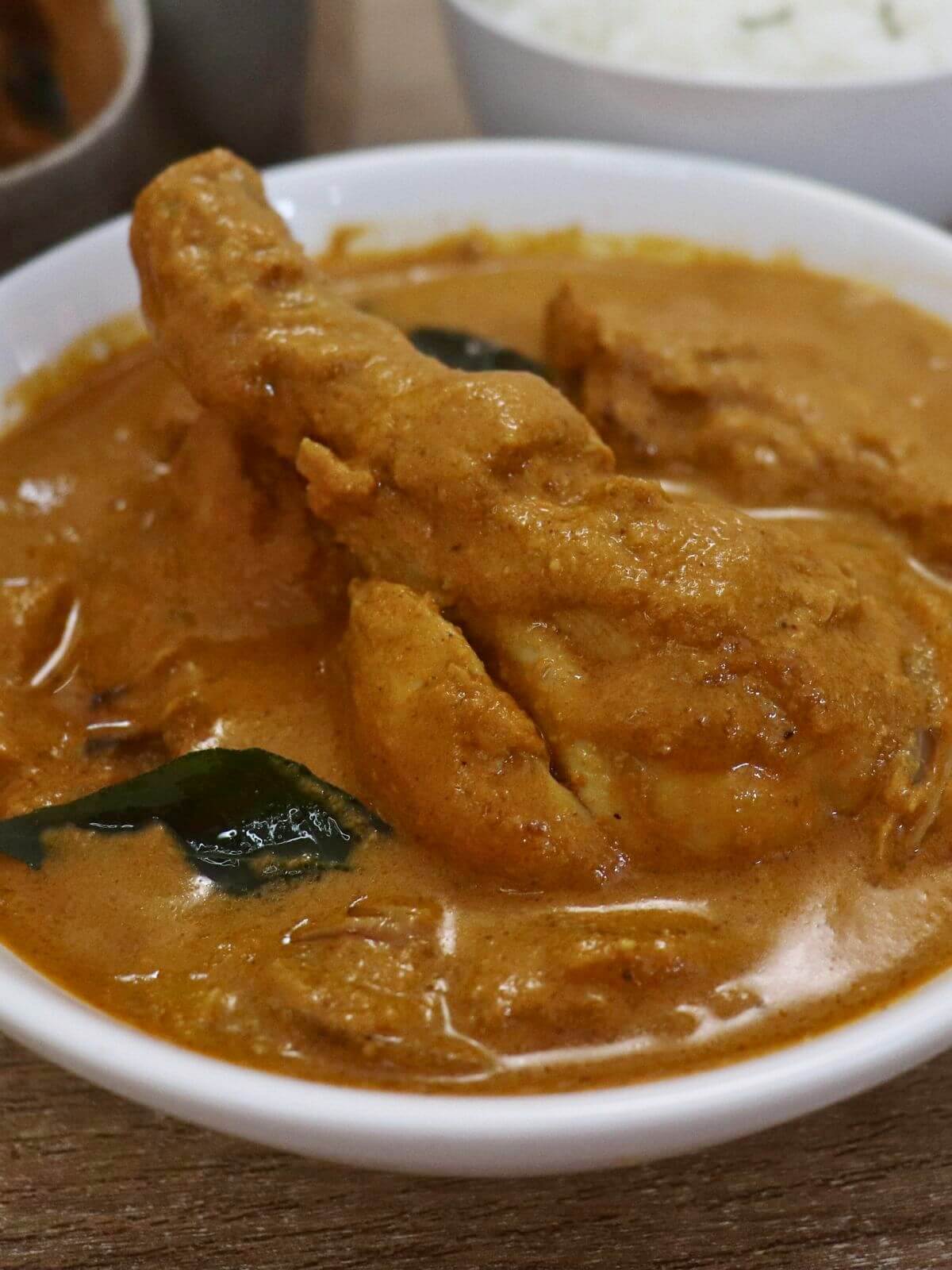
Jump to:
I love the authentic flavors in this Mangalorean chicken curry recipe. It tastes just like my mom used to make Kori Gassi. Every bite brings back happy memories of being a kid. The creamy coconut milk, fiery red chilies, and warm spices make it delicious, yet simple to prepare.
Growing up in a Mangalorean household, spicy dishes were an important part of our meals. Our table overflowed with classic dishes like this Mangalorean chicken curry, Chicken Sukka, Chicken Ghee Roast, Fish Fry, and Prawn Ghee Roast. These weren't just meals, they were traditions passed down through generations. I'm excited to share these delicious recipes with you all.
About this Mangalorean Kori Gassi
This Mangalorean chicken curry is also known as Kori Gassi in Tulu (the local language of Mangalore). Kori means "chicken" and Gassi means "curry". Kori Gassi is made with bone-in, curry-cut chicken pieces, slow-cooked in a flavorful homemade masala blend and freshly extracted coconut milk. You can also use canned coconut milk to make this chicken curry.
Coconut is available in abundance in coastal regions and we use homemade coconut milk in our South Indian curries. The sweetness and creaminess of coconut milk in this Mangalorean Kori Gassi perfectly balance the spice of the Mangalorean red masala paste.
Mangalorean red masala paste gives a unique flavor to this Kori gassi. It is versatile and can also be used as a base for other Mangalorean curries, like mutton curry or prawn curry, allowing you to create a variety of delicious dishes.
This Kori Gassi isn't just about the rich masala; the true magic unfolds with the final touch - the tempering. Crispy fried onions, sizzling in clarified butter (ghee), infuse the curry with an irresistible depth of flavor. It elevates the Mangalorean chicken curry experience, making it a true coastal delight.
You may also like these other popular chicken curry recipes from this website:
- Maharashtrian Chicken Sukka
- Black Pepper Chicken Curry
- Chicken 65 Gravy
- Pressure Cooker Chicken Curry
- Madras Chicken Curry
- Dhaba-Style Chicken Curry
- Hyderabadi Chicken Masala
Ingredients Notes
Mangalorean curries are known for their freshly ground masala. It involves roasting and grinding whole spices over low heat until fragrant releases their essential oils. This toasted spice mix is ground into a fine paste that intensifies the flavor of this Mangalorean chicken curry.
- Byadagi red chilies - These chilies give a bright red color to this Mangalore-style chicken curry and are slightly spicy. You can substitute it with Kashmiri red chilies or any dry red chili. But then adjust the quantity as per the spice level of the chilies you are using.
- Mangalorean red masala paste - It requires a few whole spices like coriander seeds, fennel seeds, mustard seeds, cumin, fenugreek seeds, black peppercorns, cinnamon, cloves, star anise, and a small piece of tamarind. You can substitute tamarind with lemon juice. If you do not have the whole spices substitute it with ½ teaspoon store-bought garam masala powder.
- Coconut - Coconut balances the spiciness by adding sweetness to the dish. In this Mangalorean chicken curry, coconut is used in two forms: coconut milk and freshly scraped coconut. I used 1 whole coconut for this curry. I reserved ½ cup of scraped coconut for the masala paste and used the remaining scraped coconut to make coconut milk for the curry. If you do not have fresh coconut substitute it with full-fat canned coconut milk.
Here's how to make this Mangalorean chicken curry.
How to make Mangalorean Chicken Curry with step-by-step photos
Preparations for Kori Gassi
1) For the marinade: Combine the chicken with turmeric powder and salt. Let the chicken marinate for 30 minutes.

2) Scrape the coconut and set it aside. If you are using canned coconut milk, you can skip this step.
3) Slice the onions and set them aside.
Making the Mangalorean red masala paste
1) Heat a pan over medium-low heat. Add ½ teaspoon of oil. Add mustard seeds, fenugreek, coriander, fennel, cinnamon, cloves, black peppercorns and cumin. Stir-fry until aromatic. Remove and set this aside on a plate.
2) In the same pan, stir-fry dried red chilies on medium heat until crisp. Remove it to the same plate.
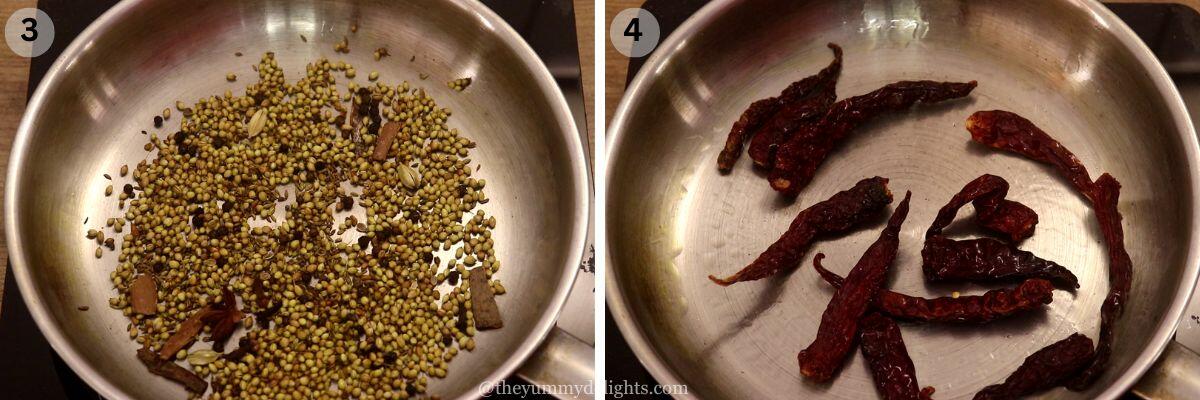
4) In the same pan, add 1 teaspoon of oil, then add ginger, garlic, and onions. Stir-fry on medium heat until the onions are golden brown. Remove it to the same plate.
5) In the same pan, add scrapped coconut and turmeric.
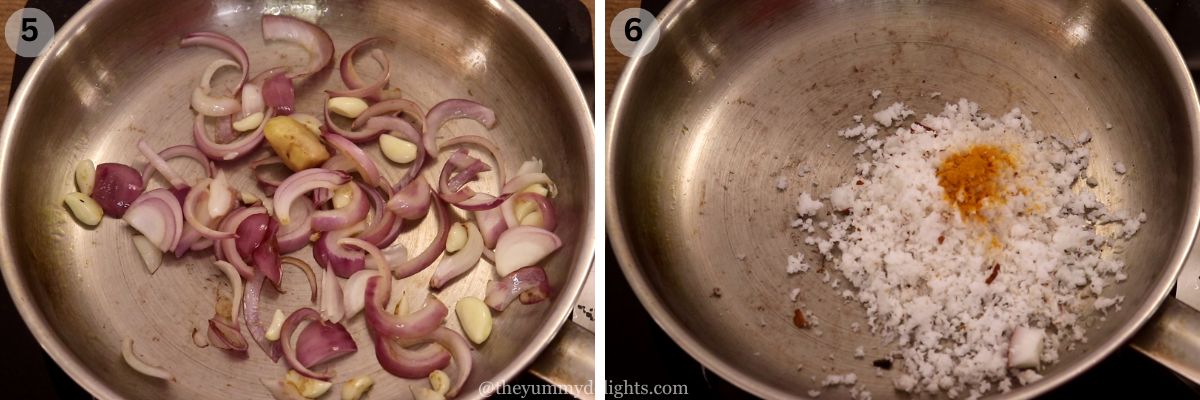
6) Roast for 2-3 minutes until the coconut starts to become golden. Remove it to the same plate. Let all the roasted ingredients cool down completely.
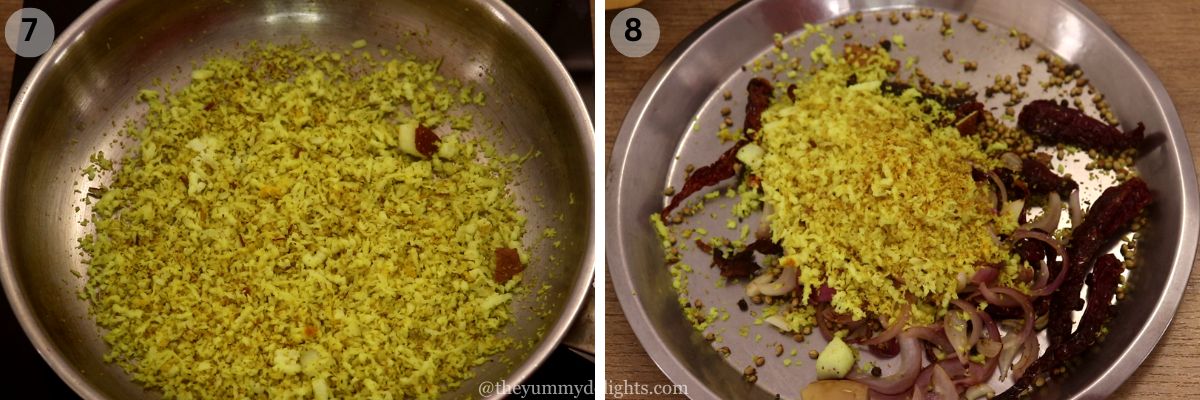
7) Break the roasted red chilies and deseed them to reduce the spiciness of the chilies (optional step).
8) Add it to the mixer or grinder jar. Add the rest of the roasted ingredients. To this add a small piece of tamarind and ½ cup water. Grind it to a smooth paste. Your homemade Mangalorean red masala paste is ready. Set this aside.
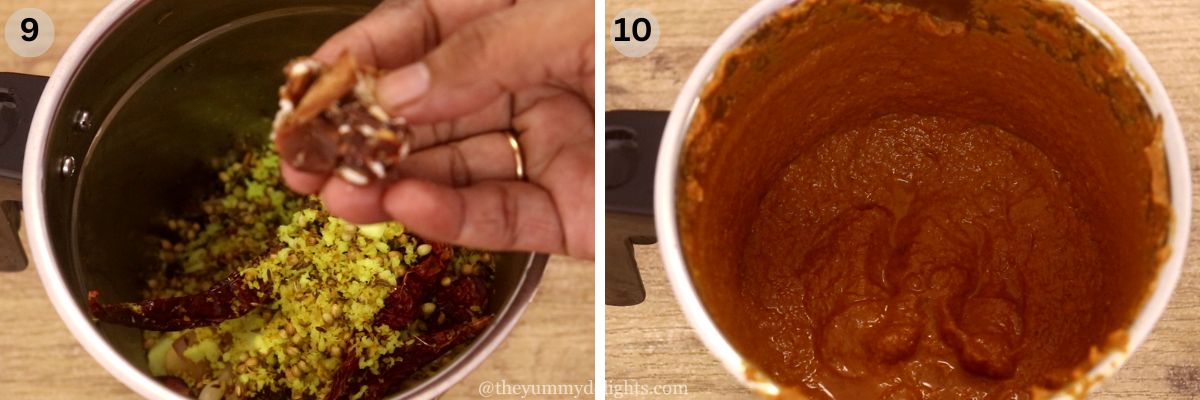
Making the Mangalorean chicken curry
1) Heat 2 teaspoons of oil and 2 teaspoons of ghee in a pan over medium heat. Add onions and curry leaves and stir-fry until onions are golden.
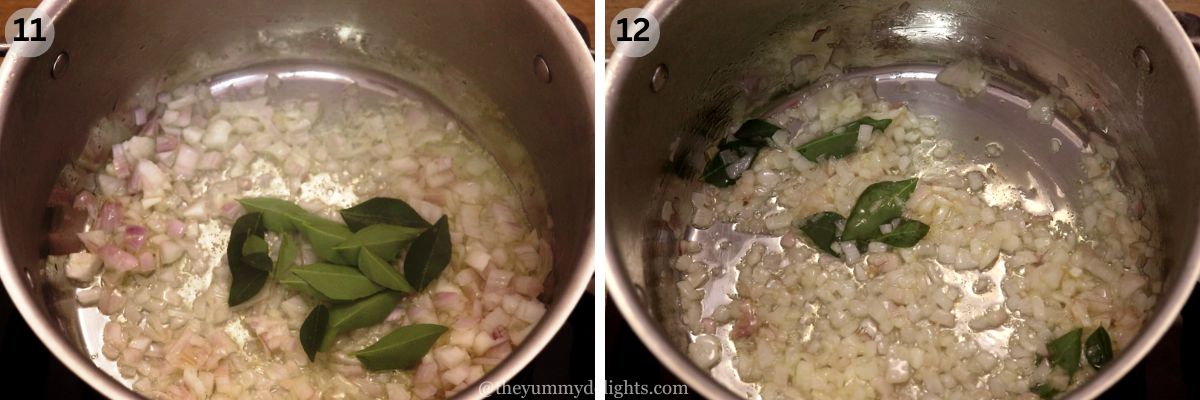
2) Add marinated chicken and stir-fry until the color of the chicken changes from pink to white.
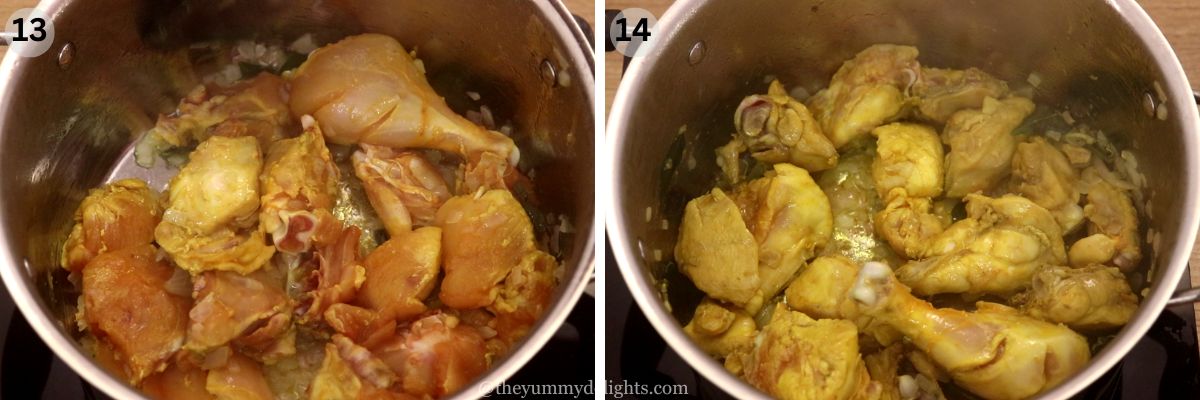
3) Cover and cook for a minute. Open the lid, add a small amount of water (about ¼ cup) to prevent sticking, and stir occasionally. Continue cooking covered until the chicken is cooked through. Be mindful not to add too much water at once, as it will thin the curry before adding the coconut milk.
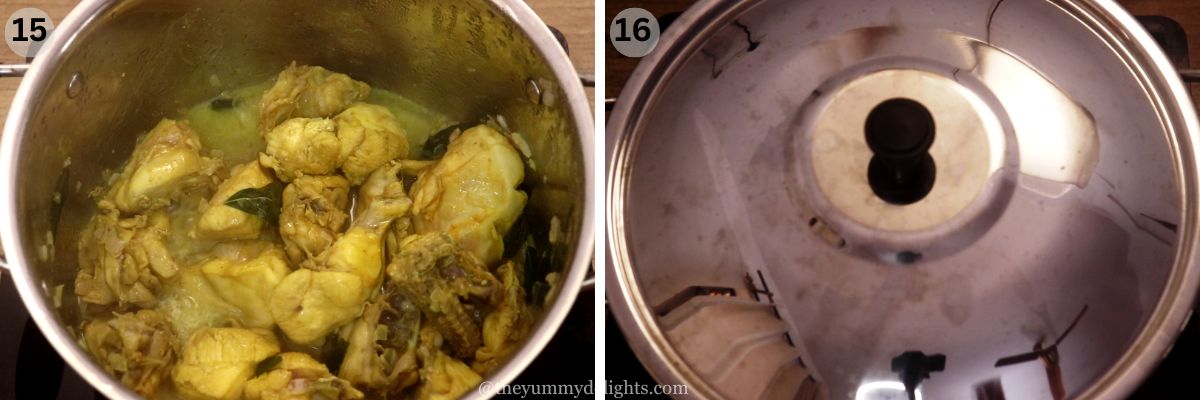
4) Add the ground red masala paste. Stir in the paste and cook until it comes to a boil.
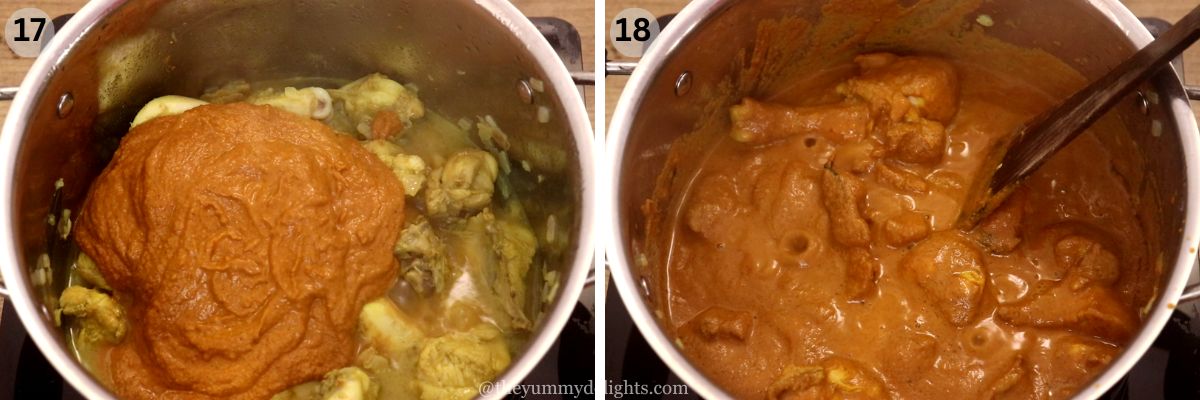
5) Add 1 cup of thin coconut milk. Let it come to a boil. Taste the gravy and add salt to taste.
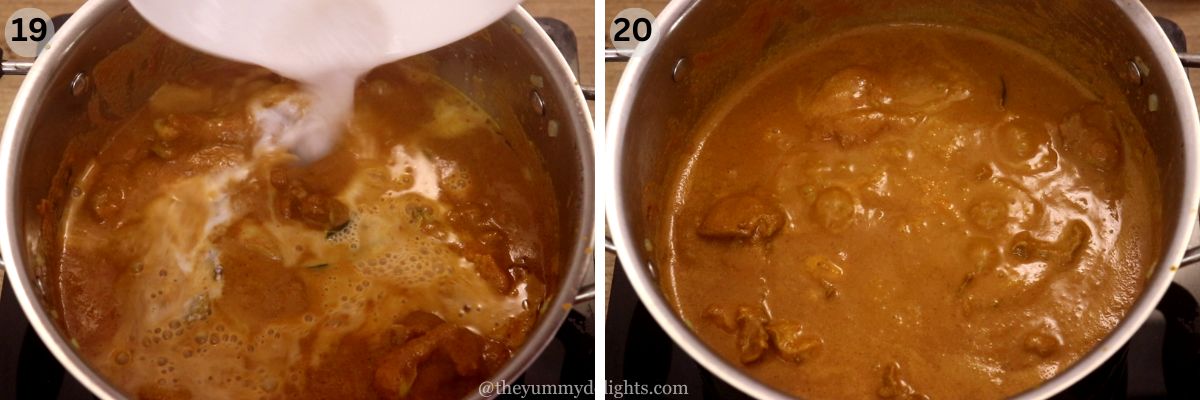
6) Reduce the heat to low. Add 1 cup of thick coconut milk. Let it simmer on low heat until a gentle boil is reached. Meanwhile, prepare the tempering.
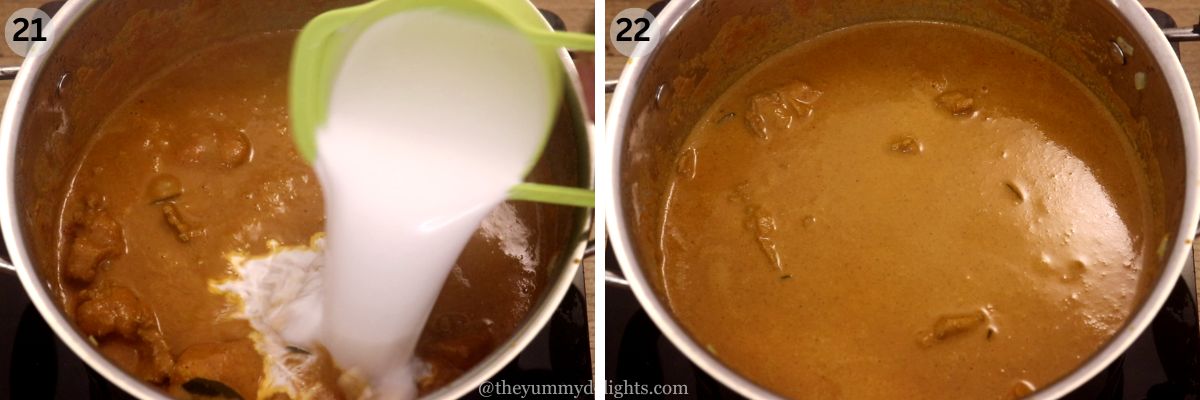
For the tempering
1) Heat 1-2 teaspoons of ghee over medium heat. Add onions and curry leaves. Stir-fry until onions are golden brown.
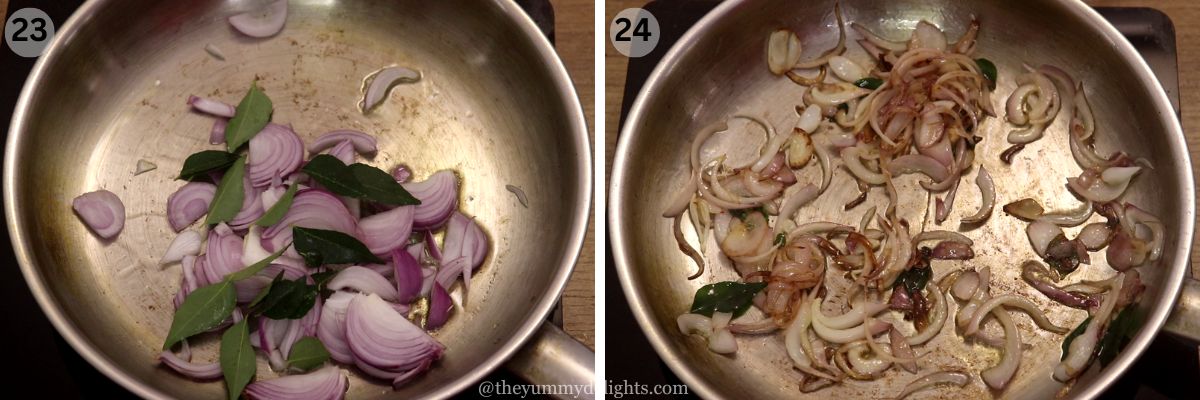
2) Add the tempered (fried) onions and curry leaves to the curry. Mangalorean chicken curry is ready to serve. Serve Kori gassi with Rice, Neer dosa, or roti.
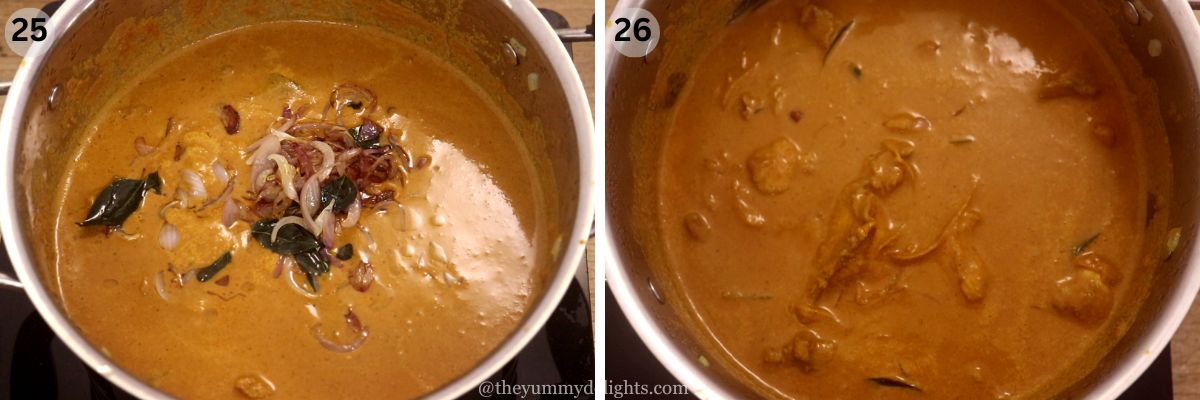
Tips to make the Best Chicken Curry
- Roasting the spices brings out the best flavors in this Mangalorean curry. Traditionally, adding a little oil while roasting spices and coconut is a common practice in Mangalorean cooking. It helps enhance the flavors and prevents burning. But you can also dry roast the spices.
- If you do not have tamarind, skip it while making red masala paste. Add lemon juice towards the end of cooking.
- You can add tomatoes to this Mangalorean curry. After the onions turn golden brown, add one chopped tomato and cook until it softens and becomes mushy. This will add a touch of sweetness and depth of flavor to the curry.
- The curry should be medium thick, not too soupy or dry.
- Ghee adds a very nice flavor to this Manglorean Kori Gassi. Don't skip tempering the onions in ghee for the best results. If you have dietary restrictions, coconut oil or vegetable oil can be used.
Frequently asked questions
Yes, it's a moderately spicy curry. However, you can easily adjust the heat level to your preference. To make it milder, simply reduce the quantity of red chilies (you can also deseed them) and increase the amount of coconut milk in this recipe. The sweetness of coconut and the tanginess of tamarind helps to balance the spiciness.
This Mangalorean chicken curry is traditionally served with Kori Rotti. These are thin, crispy rice flatbreads that are traditionally served alongside the Kori Gassi. Kori Rotti Curry is a complete meal where the Rotti soaks up the delicious flavors of the Kori Gassi. You can also serve it with Neer Dosa, Roti, or Rice.
Place 2 cups of scraped coconut in a blender/mixer jar. Add 3 cups of water (room temperature). Blend for 1-2 minutes until the mixture is smooth and creamy.
Pour the blended mixture into a strainer lined with cheesecloth or a fine-mesh strainer placed over a bowl. Use a spoon or your hand to squeeze out all the coconut milk from the pulp in the strainer. This is the first extract also called thick coconut milk. Transfer the coconut milk to another bowl. Keep it aside.
Now, put the coconut pulp back into the blender and add 1 cup of water. Grind it for 1-2 minutes. Pour the blended mixture into a strainer. Squeeze out the maximum coconut milk from the pulp. This is the second extract also called thin coconut milk.
While cooking the curry, we will use the second extract first and then add the first extract towards the end of cooking. The first extract has a high-fat content and cannot be boiled as it curdles easily. The second extract has a less fat content and can be boiled.
Kori Gassi Variations
- You can make a Mangalorean mutton curry recipe with the same process. The cooking time for mutton will be longer. Pressure cook the mutton to save time.
If you try this recipe, please leave a comment and rating below. We'd love to hear your feedback.
For any questions or concerns while making this recipe, please get in touch with me directly at nayakprety@gmail.com. I'll try my best to respond promptly.
And, consider following me on social media so we can stay connected. I’m on Facebook, Pinterest, and YouTube!
Recipe Card
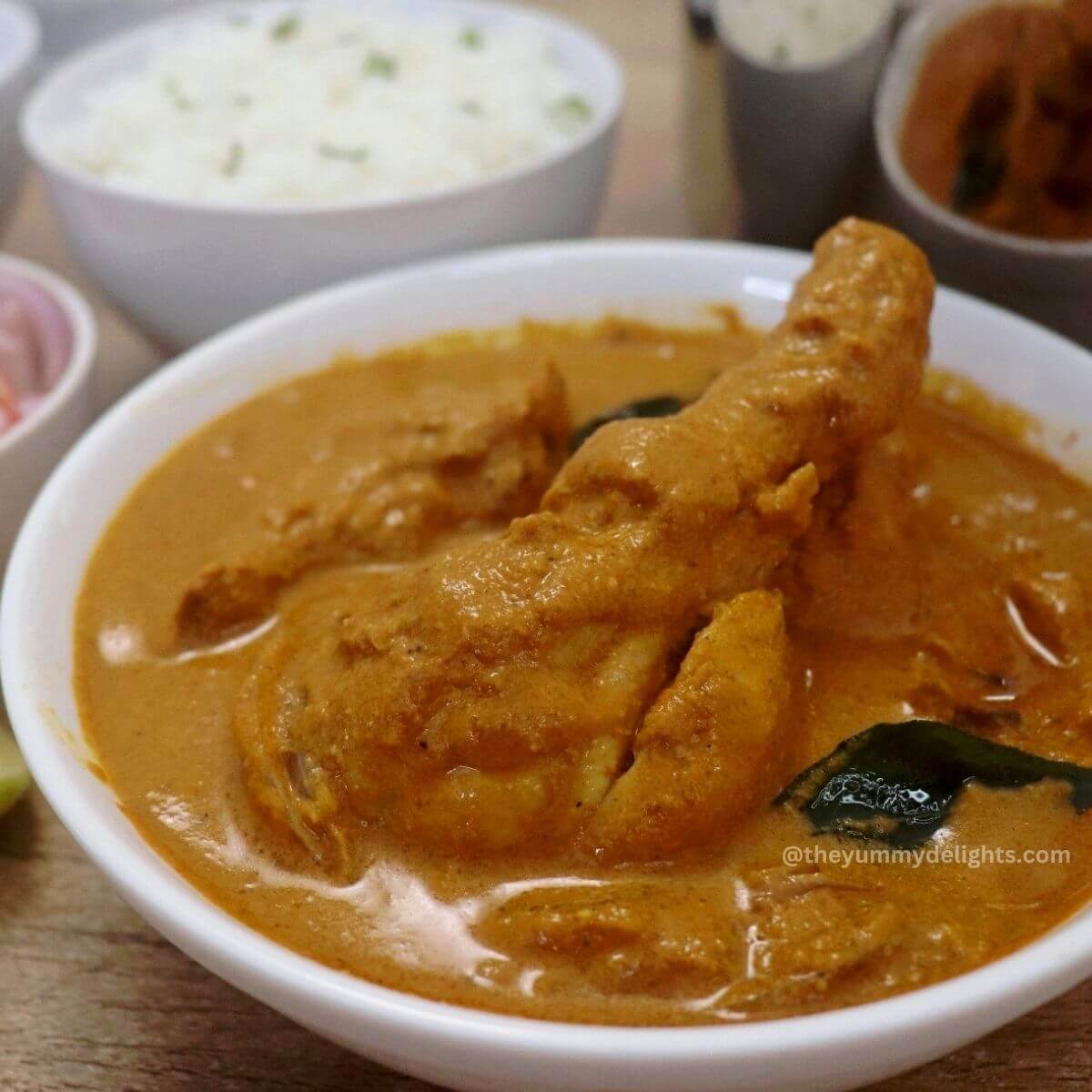
Mangalorean Chicken Curry Recipe (Kori Gassi)
Video

Equipment
- 1 large mixing bowl
- 1 Heavy bottom pan
- 1 Heavy bottom pot
Ingredients
To marinate the chicken
- 800 g bone-in chicken (curry cut)
- ¼ teaspoon turmeric powder
- ½ teaspoon salt
To make the Mangalorean red masala paste
- 1-2 teaspoon oil
- 12-15 Byadagi or Kashmiri red chilies
- 15-20 small garlic cloves or 7-8 big size garlic cloves
- 1- inch ginger
- 1 small onion, sliced
- ½ cup scraped/grated fresh coconut if using canned coconut milk skip it
- ¼ teaspoon turmeric
- a small size tamarind ball (or add lemon juice)
Whole spices
- ¼ teaspoon mustard seeds
- ¼ teaspoon fenugreek seeds
- 2 tablespoon coriander seeds
- 1 teaspoon fennel
- 1- inch cinnamon
- 4 cloves
- 1 teaspoon black peppercorns
- ½ teaspoon cumin
Other Ingredients
- 2 teaspoon oil
- 2 teaspoon ghee
- 1 small onion chopped
- 1 sprig curry leaves
- 1 cup of thin coconut milk (recipe in notes, substitute with 200 ml of canned coconut milk)
- 1 cup of thick coconut milk
Tempering
- 2 teaspoon ghee (clarified butter)
- 1 onion, sliced sliced
- 1 sprig curry leaves
Instructions
Preparations for kori gassi
- For the marinade: Combine the chicken with turmeric powder and salt. Let the chicken marinate for 30 minutes.
- Scrape the coconut and set it aside. If you are using canned coconut milk, you can skip this step.
- Slice the onions and set them aside.
Making the Mangalorean red masala paste
- Heat a pan over medium-low heat. Add ½ teaspoon of oil. Add mustard seeds, fenugreek, coriander, fennel, cinnamon, cloves, black peppercorns and cumin. Stir-fry until aromatic. Remove and set this aside on a plate.
- In the same pan, stir-fry dried red chilies on medium heat until crisp. Remove it to the same plate.
- In the same pan, add 1 teaspoon of oil, then add ginger, garlic and onions. Stir-fry on medium heat until the onions are golden brown. Remove it to the same plate.
- In the same pan, add scrapped coconut and turmeric. Roast for 2-3 minutes until coconut starts to become golden. Remove it to the same plate.
- Let all the roasted ingredients cool down completely.
- Break the roasted red chilies and deseed them to reduce the spiciness of the chilies (optional step).
- Add it to the mixer or grinder jar. Add the rest of the roasted ingredients.To this add a small piece of tamarind and ½ cup water. Grind it to a smooth paste. Your homemade Mangalorean red masala paste is ready. Set this aside.
Making the Mangalorean chicken curry
- Heat 2 teaspoon of oil and 2 teaspoon of ghee in a pan over medium heat.
- Add onions and curry leaves and stir-fry until onions are golden.
- Add marinated chicken and stir-fry until the color of the chicken changes from pink to white. Cover and cook it for a minute. Open the lid, if your chicken appears to be drying out, add ¼ cup of water and combine.
- Cover and cook for a minute. Open the lid, add a small amount of water (about ¼ cup) to prevent sticking, and stir occasionally. Continue cooking covered until the chicken is cooked through. Be mindful not to add too much water at once, as it will thin the curry before adding the coconut milk.
- Add the ground masala paste. Stir in the paste and cook until it comes to a boil.
- Add 1 cup of thin coconut milk. Let it come to a boil. If using canned coconut milk add it now.
- Taste the gravy and add salt to taste. Reduce the heat to low. Add 1 cup of thick coconut milk. Let it simmer on low heat until a gentle boil is reached. Meanwhile, prepare the tempering.
For the tempering
- Heat 1-2 teaspoons of ghee over medium heat. Add onions and curry leaves. Stir-fry until onions are golden brown. Add the tempered (fried) onions and curry leaves to the curry. Mangalorean chicken curry is ready to serve. Serve Kori gassi with Rice, Neer dosa or roti.
Notes
- Roasting the spices brings out the best flavors in this Mangalorean curry. Traditionally, adding a little oil while roasting spices and coconut is indeed a common practice in Mangalorean cooking. It helps enhance the flavors and prevents burning. But you can also dry roast the spices.
- You can reduce the spiciness of the curry by increasing the quantity of coconut milk in this recipe.
- If you do not have tamarind, skip it while making red masala paste. Add lemon juice towards the end of cooking.
- You can add tomatoes to the curry. After the onions turn golden brown, add one chopped tomato and cook until it softens and becomes mushy. This will add a touch of sweetness and depth of flavor to the curry.
- The curry should be medium thick, not too soupy or dry.
- Ghee adds depth of flavor to the curry. Don't skip tempering the onions in ghee for the best results. If you have dietary restrictions, coconut oil or vegetable oil can be used for frying the onions.
- To make homemade coconut milk - Place 2 cups of scraped coconut in a blender/mixer jar. Add 3 cups of water (room temperature). Blend for 1-2 minutes until the mixture is smooth and creamy. Pour the blended mixture into a strainer lined with cheesecloth or a fine-mesh strainer placed over a bowl. Use a spoon or your hand to squeeze out all the coconut milk from the pulp in the strainer. This is the first extract also called thick coconut milk. Transfer the coconut milk to another bowl. Keep it aside. Now, put the coconut pulp back into the blender and add 1 cup of water. Grind it for 1-2 minutes. Pour the blended mixture into a strainer. Squeeze out the maximum coconut milk from the pulp. This is the second extract of thin coconut milk. While cooking the curry, we will use the second extract first and then add the first extract towards the end of cooking. The first extract has a high-fat content and cannot be boiled as it curdles easily. The second extract has a less fat content and can be boiled.
Nutrition
Nutrition information is automatically calculated, so should only be used as an approximation.

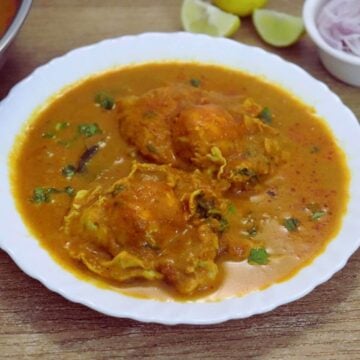



Preeti
This Mangalorean chicken curry is close to my heart. It’s rich, full of flavour, and truly authentic to our coastal style. I love that it comes together with simple pantry ingredients yet tastes so special. Try this recipe for true, authentic Mangalorean flavors.
Liz
Tried your chicken Sukka recipe. Turned out very good! Thank you for giving authentic recipes without hiding any secret ingredients. God bless
Preeti
Glad to hear that. Happy to help. Thanks and have a good day.